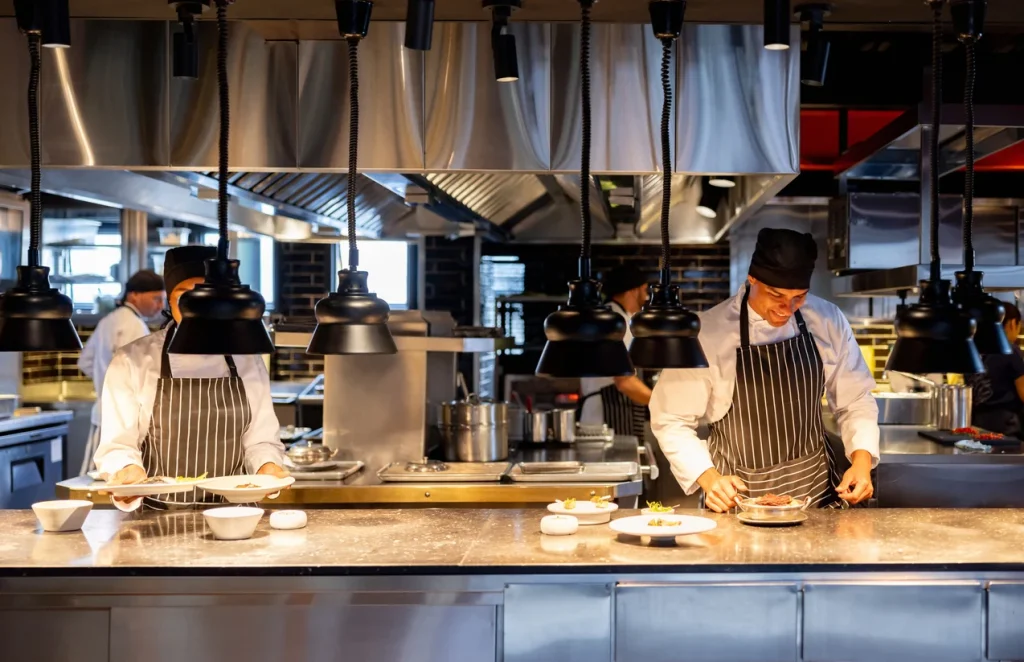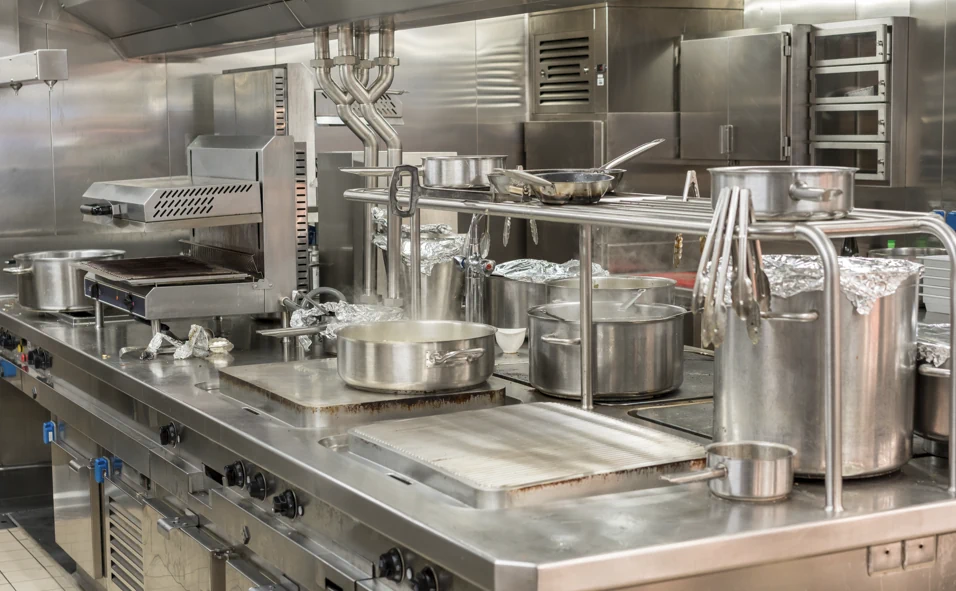The Truth Behind “The Best” Kitchen Design
Many hotels ask for the best commercial kitchen design — but most start with the wrong question. Best for what? For speed, for hygiene, for energy savings, or for ROI? We seen many hotel projects copy restaurant layouts and end up with bottlenecks, heat issues, and HACCP noncompliance. In our turnkey hospitality projects from Istanbul to Doha, the truth became clear: the best kitchen isn’t the biggest — it’s the one that fits your workflow. Built smart, not just built large. Factory-direct, Turkey-made systems now prove that efficient planning saves more than fancy design.
What Makes a Hotel Kitchen Design “The Best”?
The best kitchen design isn’t universal; it’s contextual. What works in a 400-room resort in Zanzibar fails in a 60-room boutique in Lisbon. Still, five principles define a world-class layout:
- Workflow Efficiency: From receiving to dish return, food must move in one direction — clean to dirty, never the opposite.
- Zoning & Space Planning: Hot, cold, pastry, and dishwashing areas must have proper separation for hygiene and comfort.
- Energy & Ventilation Design: Good MEP planning reduces ambient heat by 30% and energy bills by up to 20%.
- Compliance & Safety: Fire suppression, air balance, and HACCP standards aren’t optional — they’re design DNA.
- BOQ & Installation Harmony: The best design is one that matches real equipment loads, not PowerPoint drawings.
In short: the best kitchen design is one where chefs move less, energy flows better, and every piece of equipment earns its space.
Five Core Layout Models for Hotels
Layout Type | Ideal For | Energy Source | Key Benefits |
Linear Layout | Small city hotels | Gas | Simple, cost-effective, easy to maintain |
Island Layout | 5-star resorts | Hybrid | Smooth workflow, central supervision, aesthetic appeal |
Zonal Layout | Large operations | Electric | Balanced heat & noise control, clear separation of functions |
Galley Layout | Boutique hotels | Gas | Compact design, minimal ducting, fast service loops |
Open Display Layout | Live-cooking or buffet hotels | Induction | Guest engagement, safe front-of-house performance |
Hotels often combine two models — e.g., Zonal + Island — to balance workflow and visual control. In a 300-key hotel in Dubai, this hybrid cut serving time by 18% and improved ventilation flow.
Made in Turkey Advantage for Hotel Kitchens
The Turkish approach to hotel kitchen design mixes manufacturing precision with field flexibility. Istanbul-built systems come CE-certified, pre-fitted with gas/electric options, and modular for fast shipping. Compared to European suppliers, Turkey-built kitchens deliver 25% faster and cost 20–25% less over five years.
In a Rixos resort project, Turkish-built combi ovens and extraction hoods arrived pretested and labeled per the BOQ — no surprises during installation. Procurement managers in Africa and the Middle East now prefer Turkey-made systems for their climate adaptation, spare part availability, and after-sales reliability.
Factory-direct manufacturing = fewer middlemen, faster ROI.

Cost vs Performance Matrix for Hotel Kitchens
Factor | Impact on ROI | Average Improvement |
Workflow Optimization | Labor efficiency | +15% faster service time |
Ventilation Balance | Energy savings | –18% power cost annually |
Hybrid Energy Source | Long-term ROI | 22% faster payback period |
Turkey-Built Manufacturing | Lifecycle cost | 25% lower maintenance cost |
Chef Workflow Design | Food consistency | +12% guest satisfaction |
In every turnkey project, ROI doesn’t come from one decision — it’s the balance of energy, workflow, and compliance. Istanbul-based design teams now use this matrix during BOQ alignment to predict real operating savings before installation.
Regional Design Insights – Middle East vs Europe vs Africa
Hotel kitchen design needs are not the same across continents.
- Middle East: High ambient heat → focus on air balance & grease management.
- Europe: Strict fire & HACCP codes → focus on stainless zoning and modularity.
- Africa: Unstable voltage & logistics → favor hybrid systems, easy service access. Turkey-built factories adapt to all three, with region-specific gas valves, tropical condensers, and CE/ISO-certified wiring. That flexibility made them the preferred export choice in 48 countries.
Common Mistakes in Hotel Kitchen Design
Even experienced contractors fall into these traps:
- Overloading Electrical Panels: Ignoring simultaneous load factors leads to tripped breakers and downtime.
- Poor Ventilation Integration: A perfect range means nothing if the hood exhaust is underdesigned.
- Ignoring Chef Flow: Too many doors, too many detours — movement equals lost efficiency.
- Underrated Cold Room Capacity: Always design cold rooms 10–15% bigger than the menu estimate.
- Copy-Paste Layouts: Each hotel’s MEP infrastructure and menu define unique design logic.
Every mistake above costs money, time, and reputation. A proper turnkey contractor eliminates them before site work starts.
How Contractors and Consultants Decide What’s “Best”
The best hotel kitchens are not designed by architects alone. The synergy between chefs, consultants, and contractors defines success. BIM modeling now allows everyone — from F&B directors to MEP engineers — to work on the same virtual layout. In our Istanbul engineering team, we use this model to detect more than 90% of coordination issues before production.
Consultants focus on HACCP zones, contractors check service clearances, chefs test workflow speed. The outcome? A kitchen that performs like an orchestra — efficient, silent, perfectly sequenced.
Sustainability and Future-Proofing
The best kitchen design is one that lasts — technically and environmentally. Turkish factories are already implementing circular steel recovery, IoT-based maintenance alerts, and low-emission burners. Energy savings in hybrid hotel kitchens reach 28% annually, and many brands now demand sustainability certification as part of their project tender.
In 2025, “best” will mean smart, sustainable, and scalable.
FAQ – What Hoteliers Ask the Most
1. What is the most efficient kitchen layout for hotels?
The Island layout is most efficient for large hotels — it improves supervision and reduces congestion.
2. How do I ensure HACCP compliance in hotel kitchens?
Plan clear zones between hot, cold, and washing areas, and integrate stainless steel surfaces (AISI 304 grade).
3. Which energy source is best for hotels — gas or electric?
Hybrid systems combining induction + gas are now standard for energy efficiency and resilience.
4. What’s the ROI timeline for hotel kitchen upgrades?
Typically 18–24 months, depending on energy source and automation level.
5. Why choose Turkey-made kitchen systems?
Because they’re factory-tested, CE & HACCP certified, and built for extreme climate reliability.
